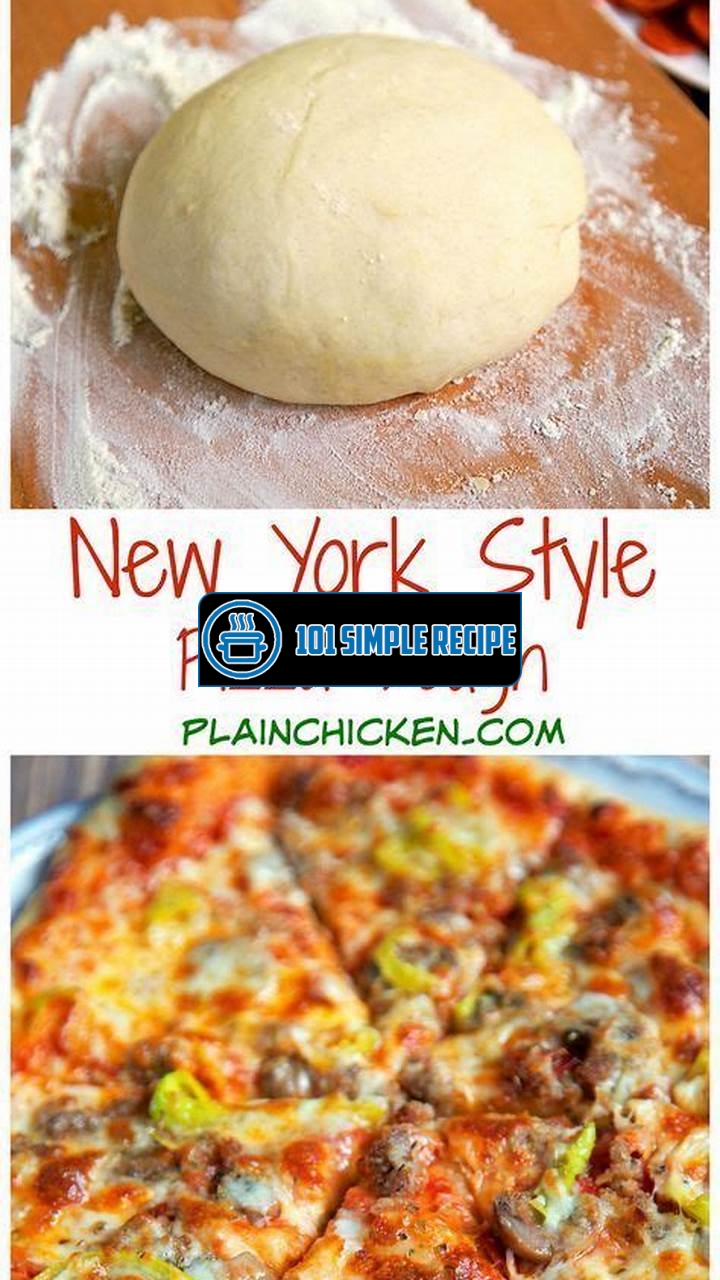Are you craving a slice of authentic New York style pizza? Look no further! In this article, you will learn how to master the art of making delicious New York style pizza dough. By following a few simple steps, you can recreate the iconic thin and crispy crust that New York is famous for right in your own kitchen. ️ Whether you are a seasoned home cook or a beginner in the culinary world, this guide will provide you with all the tips and tricks you need to achieve pizza perfection. So, tie on your apron and get ready to impress your friends and family with your homemade New York style pizza!

Understanding New York Style Pizza Dough
New York style pizza dough is known for its thin, foldable crust and delicious chewiness. It has become an iconic part of the city’s food culture and is beloved by locals and visitors alike. To truly master the art of making New York style pizza dough, it is important to understand its characteristics, history, and key ingredients.
The Origin of New York Style Pizza Dough
The origins of New York style pizza dough can be traced back to the early 1900s when Italian immigrants brought their pizza-making skills to the United States. These immigrants settled in New York City, particularly in the neighborhoods of Little Italy and Greenwich Village.
In Italy, pizza was traditionally made with a thicker, softer crust. However, in order to appeal to the large number of customers in New York City, pizza makers began to experiment with a thinner crust that could be easily folded and eaten on the go.
Over time, this thin crust became the defining characteristic of New York style pizza, setting it apart from other regional styles such as Chicago deep-dish or Neapolitan pizza.
Characteristics of New York Style Pizza Dough
One of the key characteristics of New York style pizza dough is its thinness. The dough is stretched out and hand-tossed to create a crust that is crispy on the outside and chewy on the inside. This texture is achieved by using high-gluten bread flour, which gives the dough its strength and elasticity.
Another important characteristic is the crust’s ability to fold without breaking. This makes it easy to eat on the go and gives New York style pizza its iconic appearance. The dough is also typically cooked at a high temperature, which results in a slightly charred and blistered crust.
In addition to its texture, New York style pizza dough is known for its flavorful taste. The dough is often made with a combination of water, yeast, salt, and olive oil, which enhances the overall flavor of the crust. Some recipes may also include a touch of sugar to help with browning and caramelization.
Key Ingredients in New York Style Pizza Dough
To achieve the authentic taste and texture of New York style pizza dough, it is crucial to use the right ingredients. Here are the key ingredients:
- Bread flour: High-gluten bread flour provides the necessary structure and chewiness.
- Water: Water is the main liquid ingredient that hydrates the flour and activates the yeast.
- Yeast: Yeast is responsible for fermenting the dough and creating the air bubbles that give the crust its lightness.
- Salt: Salt enhances the flavor of the dough and helps control the fermentation process.
- Olive oil: Olive oil adds richness and flavor to the dough.
- Sugar: Optional, but a small amount of sugar can aid in browning and caramelization.
By understanding the history, characteristics, and key ingredients of New York style pizza dough, you can truly master the art of making this iconic pizza. With practice and the right techniques, you’ll be able to recreate the delicious flavors and textures of New York’s beloved pizza right in your own kitchen.
No New York style pizza is complete without a great dough recipe. Check out this King Arthur pizza dough recipe to make your own mouthwatering pizza at home.
Choosing the Right Flour
When it comes to making New York style pizza dough, choosing the right flour is crucial. The type of flour you use will greatly impact the texture and flavor of your pizza crust. So, let’s dive into the different types of flour suitable for making New York style pizza dough and learn how to select the best one for your recipe.
All-Purpose vs. Bread Flour: Which is Better?
The most commonly used flours for making New York style pizza dough are all-purpose flour and bread flour. Each type has its own unique properties that can affect the final result of your pizza crust.
All-Purpose Flour: All-purpose flour is a versatile option that can be used for various baking purposes. It has a moderate protein content, usually around 10-12%. This protein content contributes to the structure and texture of the dough. All-purpose flour can produce a slightly softer and more tender crust compared to bread flour.
Bread Flour: Bread flour, on the other hand, has a higher protein content, usually around 12-14%. This higher protein content helps create a chewy and elastic texture in the dough. It also provides better gluten development, resulting in a stronger and more structured crust. If you prefer a chewier and more substantial crust, bread flour is the way to go.
Other Flour Varieties for New York style Pizza Dough
While all-purpose flour and bread flour are the most commonly used options, there are other flour varieties you can experiment with to achieve different flavors and textures in your New York style pizza dough.
Whole Wheat Flour: Whole wheat flour adds a nutty flavor and a denser texture to the pizza crust. It is a healthier option as it contains more fiber and nutrients compared to refined flours.
Caputo 00 Flour: Caputo 00 flour is an Italian flour specifically designed for making pizza. It has a low protein content, around 12.5%, and results in a thin and crispy crust with a soft interior.
Semolina Flour: Semolina flour is coarser in texture and gives a slightly yellow color to the dough. It creates a crispy and chewy crust, perfect for those who enjoy a heartier bite.
Considerations for Gluten-Free Pizza Dough
If you have a gluten intolerance or follow a gluten-free diet, you can still enjoy delicious New York style pizza by using alternative flours and ingredients.
Gluten-Free Flour Blends: There are gluten-free flour blends available in the market that are specifically formulated to mimic the texture and flavor of traditional pizza dough. These blends often consist of a combination of rice flour, tapioca flour, and potato starch.
Almond Flour: Almond flour is a popular gluten-free alternative as it adds a rich and slightly nutty flavor to the dough. It creates a crust that is more delicate and crumbly compared to traditional wheat-based dough.
Cauliflower Crust: For a truly grain-free option, you can make a pizza crust using cauliflower rice. This alternative crust is low in carbohydrates and provides a unique and lighter texture.
Now that you’re equipped with knowledge about different flour options for making New York style pizza dough, you can confidently experiment and find the perfect flour that suits your taste and dietary preferences. Happy pizza making!
If you love pizza, you might also enjoy trying out different recipes. Check out this King Arthur pizza dough recipe for a unique twist on making New York style pizza dough.
Mastering the Dough Recipe
When it comes to making New York style pizza dough, mastering the recipe is essential to achieve the perfect texture and flavor. By following the step-by-step process and implementing some key tips and tricks, you can create a dough that rivals the best pizzerias in the Big Apple.
Key Ingredients for New York Style Pizza Dough Recipe
Before diving into the dough-making process, it’s important to gather the right ingredients. To create an authentic New York style pizza dough, you’ll need:
- High-gluten flour: This type of flour, also known as bread flour, contains a higher protein content which helps create a chewy and elastic dough.
- Water: Using cold water is crucial as it slows down fermentation and allows the dough to develop its characteristic texture.
- Yeast: Active dry yeast is typically used in New York style pizza dough recipes. It’s important to proof the yeast in warm water to ensure it’s active and ready to leaven the dough.
- Salt: Salt enhances the flavor of the dough and helps regulate fermentation.
- Sugar: A small amount of sugar is added to provide food for the yeast and promote fermentation.
- Olive oil: While not a traditional ingredient in New York style pizza dough, some recipes call for a small amount of olive oil to add richness and flavor.
Proper Mixing and Kneading Techniques
Once you have gathered all the ingredients, the next critical step is to mix and knead the dough properly. The mixing and kneading process helps develop gluten, which gives the dough its stretchy and elastic characteristics.
To mix the dough, combine the flour, yeast, sugar, and salt in a large bowl. Gradually add the water and olive oil while stirring with a wooden spoon. Once the ingredients come together, transfer the dough onto a clean, floured surface.
Now, it’s time to knead the dough. Use the heel of your hand to push down and stretch the dough away from you. Fold the dough over and repeat the process. Continue kneading for at least 10 minutes until the dough becomes smooth and elastic.
Remember, kneading is a crucial step in developing the gluten structure, so don’t rush this process. It’s normal for the dough to be sticky at first, but as you continue kneading, it will become more manageable.
The Importance of Resting and Proofing the Dough
Resting and proofing the dough are crucial steps that cannot be skipped. These stages allow the yeast to ferment and develop flavors, resulting in a light and airy crust.
After kneading the dough, shape it into a ball and place it in a greased bowl. Cover the bowl with a kitchen towel or plastic wrap and let it rest at room temperature for about 1-2 hours. This rest period helps relax the gluten and allows the dough to rise.
Once the dough has rested, it’s time for proofing. Gently punch down the dough to release any air bubbles and divide it into individual portions. Shape each portion into a ball and place them on a floured surface, making sure to keep some space between them. Cover the dough balls with a kitchen towel and let them proof for an additional 1-2 hours.
During the proofing stage, the dough will rise further and develop more complex flavors. It’s important to note that the exact resting and proofing times may vary depending on the temperature and humidity of your environment. Keep an eye on the dough and look for signs that it has doubled in size before proceeding.
By mastering the dough recipe, understanding the key ingredients, and implementing proper mixing, kneading, resting, and proofing techniques, you’ll be well on your way to creating delicious New York style pizza dough. Practice makes perfect, so don’t be discouraged if your first attempt isn’t flawless. With time and experience, you’ll become a master in the art of making New York style pizza dough.
Looking for a variation on New York style pizza dough? Try this King Arthur pizza dough recipe for a delicious and satisfying alternative.
Hand-Tossed vs. Rolling Pin: Choosing the Right Method
When it comes to shaping New York style pizza dough, there are different techniques you can use. Two popular methods include hand-tossing and using a rolling pin. Each method has its own pros and cons, and it’s important to understand the differences before deciding which one is right for you.
The Classic Hand-Tossed Technique
The hand-tossed technique is the traditional way of shaping New York style pizza dough. It involves stretching and tossing the dough in the air to create a thin and round crust. This method requires practice and skill, but it can result in a more authentic and artisanal pizza.
An emoji can be added here to emphasize the importance of the hand-tossed technique.
One of the advantages of hand-tossing is that it allows you to create a crust with varying thickness. By manipulating the dough with your hands, you can achieve a thinner center and a slightly thicker outer edge, which is characteristic of New York style pizza.
Another advantage of hand-tossing is that it helps develop gluten in the dough, resulting in a chewier texture. The act of stretching and tossing the dough activates the gluten strands, creating a light and airy crust when baked.
However, hand-tossing does require some skill and practice to master. It takes time to get the hang of tossing the dough without tearing or misshaping it. If you’re a beginner or don’t feel confident in your tossing abilities, you may prefer to use a rolling pin.
Using a Rolling Pin: Pros and Cons
Using a rolling pin is an alternative method for shaping New York style pizza dough. This technique involves rolling the dough out on a flat surface to achieve the desired thickness and shape. While it may not be as traditional as hand-tossing, it does offer its own set of advantages.
One of the pros of using a rolling pin is that it provides more control over the thickness of the dough. By applying even pressure with the rolling pin, you can ensure that the crust is uniform in thickness, which can result in a more evenly baked pizza.
Additionally, using a rolling pin can be faster and more efficient than hand-tossing, especially if you’re making a large batch of pizzas. It requires less physical effort and can help you achieve consistent results.
However, using a rolling pin may result in a denser and less airy crust compared to hand-tossed dough. The rolling action compresses the dough, which can lead to a more compact texture. If you prefer a lighter and chewier crust, you may want to stick to the hand-tossed technique.
Alternative Methods for Shaping New York Style Pizza Dough
If neither hand-tossing nor using a rolling pin appeals to you, there are alternative methods you can try for shaping New York style pizza dough.
One such method is using a dough press. A dough press is a tool that helps you flatten the dough evenly and quickly. It eliminates the need for hand-tossing or rolling, making it a convenient option for those who want to save time and effort.
Another alternative method is using a pizza screen or peel. These tools allow you to stretch and shape the dough directly on the screen or peel, eliminating the need for additional surfaces or utensils.
Ultimately, the method you choose for shaping New York style pizza dough depends on your personal preference and the results you want to achieve. Whether you opt for the traditional hand-tossed technique, the controlled precision of a rolling pin, or an alternative method like a dough press or pizza screen, the key is practice and finding what works best for you.
The Art of Baking New York Style Pizza
Discover the secrets to baking New York style pizza like a professional, including tips on oven temperature, baking stones, and achieving the perfect crust.
Baking Equipment: Choosing the Right Oven
When it comes to baking New York style pizza, choosing the right oven is crucial. To achieve that perfect crust, you want an oven that can reach high temperatures, ideally around 500 to 550 degrees Fahrenheit (260 to 290 degrees Celsius). This high heat is necessary for creating that signature crispy yet chewy crust that New York style pizza is known for.
It’s recommended to use a conventional oven with heating elements both at the top and bottom, ensuring that the heat is evenly distributed. This will help prevent any hot spots that could burn the crust. Avoid using toaster ovens or countertop ovens, as they typically don’t reach the high temperatures required for baking New York style pizza.
Another important consideration is the oven’s size. New York style pizzas are typically large and require plenty of space to expand and cook evenly. Ensure that your oven has enough space to accommodate the size of the pizza you plan to bake.
Importance of Preheating and Proper Stone Placement
Preheating your oven is crucial for baking New York style pizza. Allow the oven to preheat for at least 30 minutes before placing the pizza in. This ensures that the oven reaches the desired temperature and provides optimal heat distribution.
Using a baking stone is highly recommended for achieving a New York style crust. The stone absorbs and retains heat, helping to create that crispy bottom crust. Place the baking stone in the oven during the preheating process, allowing it to heat up along with the oven.
Position the baking stone on the middle rack of the oven for even heat distribution. This placement allows the pizza to cook from both the top and bottom, ensuring a perfectly cooked crust.
Techniques for Achieving a Crispy, Chewy Crust
Mastering the art of making New York style pizza dough involves certain techniques that contribute to the desired crispy yet chewy crust. Here are some key tips to achieve that perfect crust:
- Proper kneading: Knead the dough until it becomes smooth and elastic. This helps develop the gluten, giving the crust its structure and chewiness.
- Cold fermentation: After kneading, allow the dough to rise in the refrigerator overnight. This slow fermentation process enhances the flavor and texture of the crust.
- Stretching the dough: Gently stretch the dough by hand or with a rolling pin, aiming for a thin and even consistency. This prevents the crust from becoming too thick and doughy.
- Poke the dough: Before topping the pizza, use a fork or your fingertips to poke the dough gently. This prevents excessive bubbling during baking and helps maintain an even, flat surface.
By following these techniques and incorporating the tips mentioned earlier, you’ll be well on your way to mastering the art of making New York style pizza dough. Remember, practice makes perfect, so don’t be discouraged if your first attempts aren’t flawless. Keep tweaking and experimenting until you achieve the perfect New York style pizza crust!
Thank you for reading this article on how to make New York style pizza dough. We hope you found the instructions and tips helpful in recreating this iconic pizza at home. Whether you’re a seasoned pizza maker or a beginner, mastering the art of New York style pizza dough can be a rewarding experience.
If you have any further questions or need additional guidance, please feel free to reach out to us. We are here to help you on your pizza-making journey. Visit our website again for more delicious recipes, cooking techniques, and inspiration to elevate your culinary skills. Until then, happy pizza making!
Frequently Asked Questions
Here are some commonly asked questions about making New York style pizza dough:
| No. | Questions | Answers |
|---|---|---|
| 1. | How can I achieve a crispy crust with New York style pizza dough? | To achieve a crispy crust, make sure to preheat your oven at a high temperature (around 500°F/260°C) and use a pizza stone or baking steel. Stretch the dough thin and let it rest before adding the toppings. Bake the pizza on the hot stone or steel for a shorter amount of time to achieve a crispy yet chewy crust. |
| 2. | Can I make the dough in advance? | Yes, you can make New York style pizza dough in advance. After the dough has risen, you can refrigerate it for up to 48 hours. This will develop more flavor in the dough. When you’re ready to use it, take it out of the fridge, let it come to room temperature, and proceed with shaping and baking. |
| 3. | Can I freeze the dough? | Absolutely! If you have leftover dough or want to make a big batch for future use, you can freeze it. After the dough has risen, divide it into portions and wrap each portion tightly in plastic wrap. Place them in a freezer bag and freeze for up to 3 months. To use, thaw the dough in the refrigerator overnight and then let it come to room temperature before shaping and baking. |
| 4. | What makes New York style pizza dough different from other pizza dough? | New York style pizza dough is known for its thin and crispy yet chewy crust. It is made with high-gluten flour, which gives it the characteristic texture. The dough is typically hand-tossed to create a thin crust that can be folded in half and eaten on the go. The use of olive oil in the dough also adds flavor and richness. |
| 5. | Can I use a different type of flour? | While high-gluten flour is traditionally used for New York style pizza dough, you can experiment with different types of flour to achieve different results. For a lighter and softer crust, you can use bread flour. For a crispier crust, you can try using a combination of bread flour and all-purpose flour. Just keep in mind that the texture and flavor may vary. |
| 6. | Can I use a different type of yeast? | Yes, you can use instant yeast or active dry yeast interchangeably in this recipe. However, if using active dry yeast, you will need to activate it in warm water before adding it to the dough. Follow the instructions on the yeast package for the correct measurements and temperature. |
New York Style Pizza Dough Recipe
Here’s the recipe for making delicious New York style pizza dough:
Jump to Recipe
New York Style Pizza Dough

Learn how to make authentic New York style pizza dough at home with this easy recipe. Get the perfect thin and crispy yet chewy crust!
- 3 1/2 cups bread flour
- 2 teaspoons instant yeast
- 2 teaspoons salt
- 1 1/3 cups warm water
- 2 tablespoons olive oil
- In a large mixing bowl, combine the bread flour, instant yeast, and salt.
- Add the warm water and olive oil to the dry ingredients. Mix until a dough forms.
- Transfer the dough to a floured surface and knead for 5-7 minutes, or until smooth and elastic.
- Place the dough in a greased bowl, cover with a clean kitchen towel, and let it rise for 2 hours, or until doubled in size.
- Punch down the dough and divide it into 4 equal portions. Shape each portion into a ball and let them rest for 10 minutes.
- Preheat your oven to 500°F (260°C) with a pizza stone or baking steel inside.
- Working with one dough ball at a time, stretch it into a thin crust by pressing down and gently pulling the edges. Avoid using a rolling pin.
- Transfer the stretched dough to a piece of parchment paper.
- Add your desired toppings, such as tomato sauce, cheese, and toppings of your choice.
- Slide the pizza, along with the parchment paper, onto the preheated pizza stone or baking steel.
- Bake for about 8-10 minutes, or until the crust is golden brown and the cheese is bubbly and slightly browned.
- Carefully remove the pizza from the oven and let it cool for a few minutes before slicing and serving.






